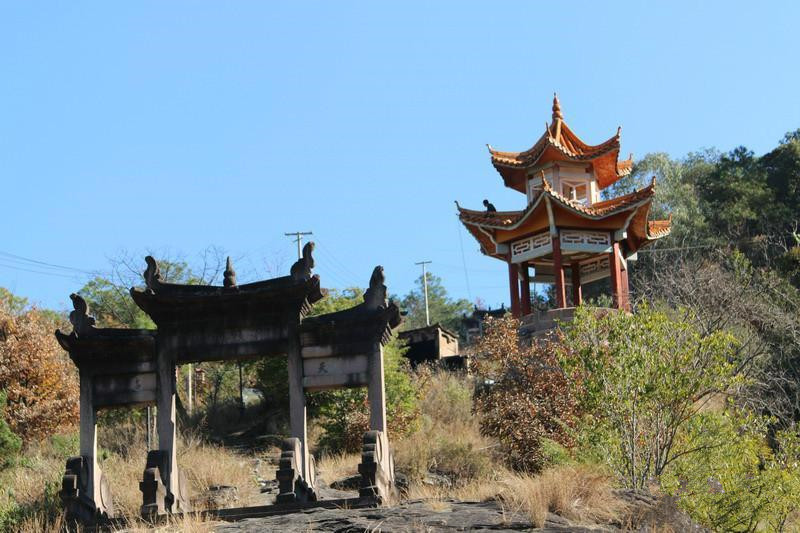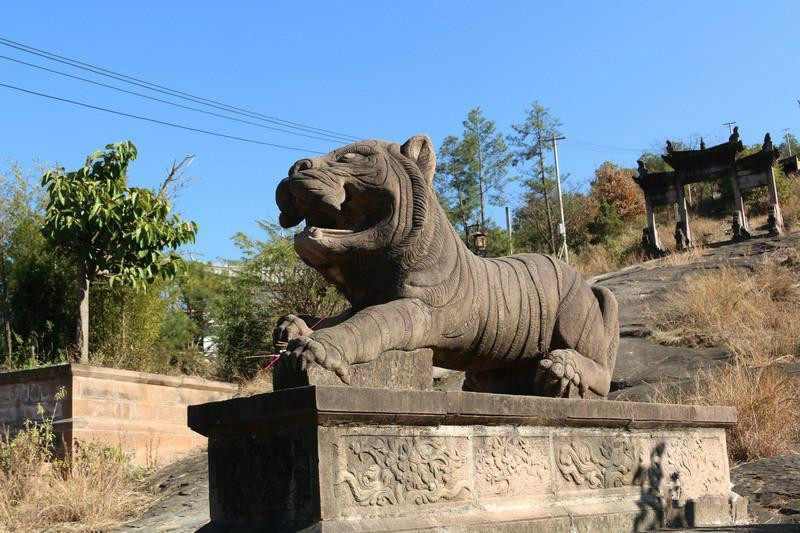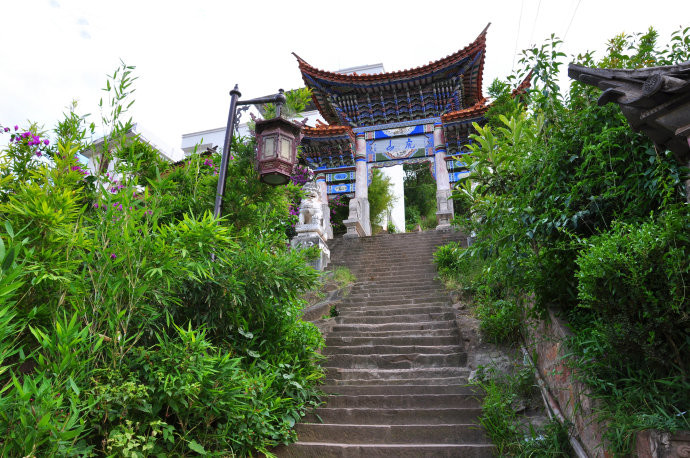Hutoushan Mountain in Yunlong County, Dali
Hutoushan Mountain (虎头山) is located in the southeastern corner of Yunlong County (云龙县), Dali (大理), Yunnan Province (云南省). Its name derives from its distinctive shape resembling a tiger’s head. The mountain is conveniently close to the county town, making it easily accessible by foot.
Major Attractions
Banshan Pavilion (半山亭)

This pavilion offers breathtaking views of Yunlong County, showcasing the winding Bi River (沘江) as it flows gracefully around the town. From here, visitors can enjoy the harmonious blend of mountains and water, elevating the overall experience.
Xianren Fan (仙人扇)
Ascending to Huatai, the path divides into two directions. The left path leads to the legendary “Xianren Fan,” believed to be a resting place for immortals. Visitors can find stone artifacts such as the Stone Fan, Stone Bed, and Stone Staff, alongside the captivating stone sculpture of a tiger that enhances the site’s mythos.
Longquan and Huch池 (龙泉、虎池)
These two clear reservoirs, located in a mountain gorge, are known for their pristine waters. Surrounded by lush Yunnan pines (云南松), the serene atmosphere is accentuated by the gentle breeze, creating a peaceful retreat.
Historical Background
In the early Ming Dynasty (明朝), a mountain god temple was established at the summit of Hutoushan. During the Honghua period, Zhenwu Pavilion (真武阁) was built, followed by several Taoist temples from the Qianlong era to the Republic of China. The area has seen extensive renovations, including the construction of Longquan and Huch池, enhancing its status as a scenic leisure destination where nature and culture intertwine.
Cultural Significance

According to the inscription on the “Tiger Mountain Stele” (虎山碑记): “Layers of peaks rise high, overlooking the azure expanse; flying pavilions and flowing colors stand out against the sky.” Recent restorations have seamlessly integrated new structures with ancient architecture, particularly evident in the couplets adorning stone arches and pavilions, which resonate with the county’s poetic heritage.
Hutou Temple (虎头寺)
Hutou Temple is a renowned ancient temple in the Dali region, located on the cliffs of Hutoushan. The front hall, known as Guixiang Tower (桂香楼), offers a panoramic view of Yunlong County. The rear hall, or Mahavira Hall (大雄宝殿), features the Three Body Buddha statues, including Shakyamuni (释迦牟尼佛), alongside various protective deities.
Ancient Trees and Surroundings
Behind Hutou Temple stand two ancient banyan trees, each several hundred years old, providing shade and tranquility. Nearby, Wangmu Temple (王母寺) is nestled among towering trees, creating a serene environment characterized by gnarled pines and cool mountain breezes.
Hutou Mountain Ancient Architecture Group
The ancient architecture group on Hutoushan is situated to the south of Shimen Town (石门镇) in Yunlong County. It is defined by a prominent peak resembling a tiger’s head and is primarily composed of Taoist buildings. Historical records indicate that Hutou Temple originally housed a mountain god temple, with subsequent constructions like the Laojun Hall and Caishen Hall (财神殿) built during the Daoguang era.
How to Get There
Hutoushan Mountain is easily accessible:
- By Car: From Dali Passenger Transport Station, take the Hanguang Expressway (杭瑞高速) to S236, following the signs to Hutoushan.
- Public Transport: Local buses frequently travel to Yunlong County.
Travel Tips
- Comfortable Footwear: The terrain can be rugged, so sturdy shoes are recommended for hiking.
- Weather Preparedness: Dress in layers as mountain weather can change rapidly; bringing a raincoat is advisable.
- Hydration: Carry sufficient water, especially during warmer months, to stay refreshed.
- Respect for Nature: Adhere to local guidelines to preserve the natural beauty of the area.
- Cultural Awareness: Be respectful when visiting temples; observe local customs and maintain a quiet demeanor.

 7 Days GolfingTour
7 Days GolfingTour
 8 Days Group Tour
8 Days Group Tour
 8 Days Yunnan Tour
8 Days Yunnan Tour
 7 Days Shangri La Hiking
7 Days Shangri La Hiking
 11 Days Yunnan Tour
11 Days Yunnan Tour
 6 Days Yuanyang Terraces
6 Days Yuanyang Terraces
 11 Days Yunnan Tour
11 Days Yunnan Tour
 8 Days South Yunnan
8 Days South Yunnan
 7 Days Tea Tour
7 Days Tea Tour
 8 Days Muslim Tour
8 Days Muslim Tour
 12 Days Self-Driving
12 Days Self-Driving
 4 Days Haba Climbing
4 Days Haba Climbing
 Tiger Leaping Gorge
Tiger Leaping Gorge
 Stone Forest
Stone Forest
 Yunnan-Tibet
Yunnan-Tibet
 Hani Rice Terraces
Hani Rice Terraces
 Kunming
Kunming
 Lijiang
Lijiang
 Shangri-la
Shangri-la
 Dali
Dali
 XishuangBanna
XishuangBanna
 Honghe
Honghe
 Kunming
Kunming
 Lijiang
Lijiang
 Shangri-la
Shangri-la
 Yuanyang Rice Terraces
Yuanyang Rice Terraces
 Nujiang
Nujiang
 XishuangBanna
XishuangBanna
 Spring City Golf
Spring City Golf
 Snow Mountain Golf
Snow Mountain Golf
 Stone Mountain Golf
Stone Mountain Golf














